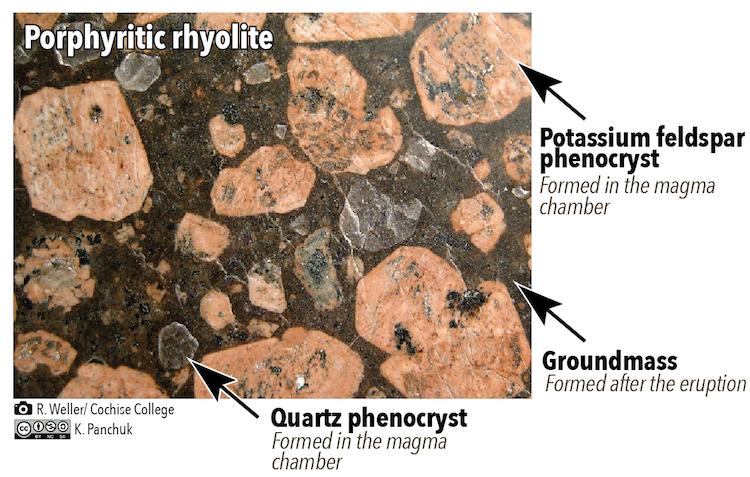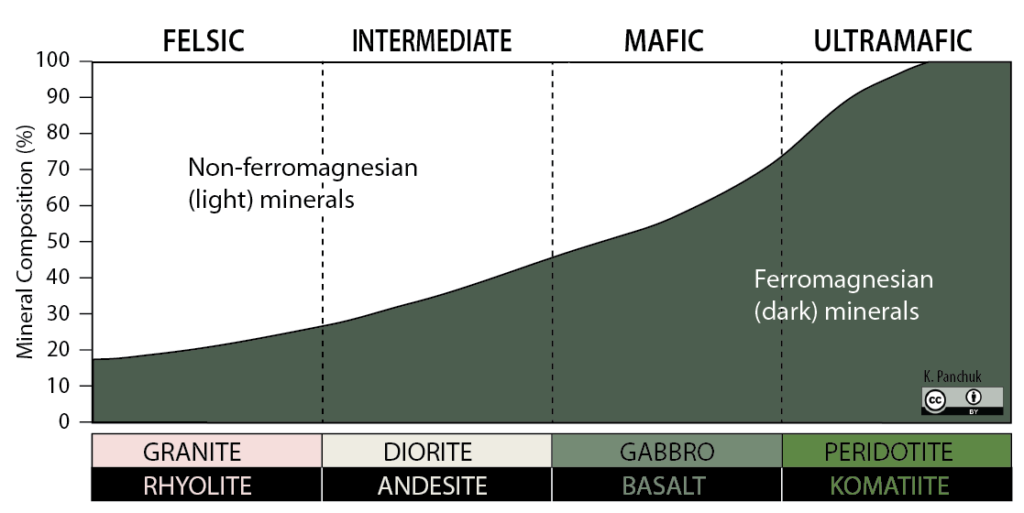7.3 Classification of Igneous Rocks
Classification By Mineral Abundance
Igneous rocks can be divided into four categories based on their chemical composition: felsic, intermediate, mafic, and ultramafic. The diagram of Bowen’s reaction series (Figure 7.6) shows that differences in chemical composition correspond to differences in the types of minerals within an igneous rock. Igneous rocks are given names based on the proportion of different minerals they contain. Figure 7.13 is a diagram with the minerals from Bowen’s reaction series, and is used to decide which name to give an igneous rock.

To see how Figure 7.13 works, first notice the scale in percent along the vertical axis. The interval between each tick mark represents 10% of the minerals within a rock by volume. An igneous rock can be represented as a vertical line drawn through the diagram, and the vertical scale used to break down the proportion of each mineral it contains. For example, the arrows in the mafic field of the diagram represent a rock containing 48% pyroxene and 52% plagioclase feldspar. An igneous rock at the boundary between the mafic and ultramafic fields (marked with a vertical dashed line) would have approximately 20% olivine, 50% pyroxene, and 30% Ca-rich plagioclase feldspar by volume.
Classification By Grain Size
The name an igneous rock gets also depends on whether it cools within Earth (an intrusive or plutonic igneous rock), or whether it cools on the Earth’s surface after erupting from a volcano (an extrusive or volcanic igneous rock). For example, a felsic intrusive rock is called granite, whereas a felsic extrusive rock is called rhyolite. Granite and rhyolite have the same mineral composition, but their grain size gives each a distinct appearance.
The key difference between intrusive and extrusive igneous rocks—the size of crystals making them up—is related to how rapidly melted rock cools. The longer melted rock has to cool, the larger the crystals within it can become. Magma cools much slower within Earth than on Earth’s surface because magma within Earth is insulated by surrounding rock. Notice that in Figure 7.13, the intrusive rocks have crystals large enough that you can see individual crystals—either by identifying their boundaries, or seeing light reflecting from a crystal face. A rock with individual crystals that are visible to the unaided eye has a phaneritic or coarse-grained texture. The extrusive rocks in the second row have much smaller crystals. The crystals are so small that individual crystals cannot be distinguished, and the rock looks like a dull mass. A rock with crystals that are too small to see with the unaided eye has an aphanitic or fine-grained texture. Table 7.1 summarizes the key differences between intrusive and extrusive igneous rocks.
| Table 7.1 Comparison of Intrusive and Extrusive Igneous Rocks | ||
| Magma cools within Earth | Lava cools on Earth’s surface | |
| Terminology | Intrusive/ plutonic | Extrusive/ volcanic |
| Cooling rate | Slow: surrounding rocks insulate the magma chamber. | Rapid: heat is exchanged with the atmosphere. |
| Texture | Phaneritic (coarse-grained): individual crystals are large enough to see without magnification. | Aphanitic (fine-grained): crystals are too small to see without magnification. |
What this means is that two igneous rocks comprised of exactly the same minerals, and in the exactly the same proportions, can have different names. A rock of intermediate composition is diorite if it is course-grained, and andesite if it is fine-grained. A mafic rock is gabbro if it is course-grained, and basalt if fine-grained. The course-grained version of an ultramafic rock is peridotite, and the fine-grained version is komatiite. It makes sense to use different names because rocks of different grain sizes form in different ways and in different geological settings.
Does This Mean an Igneous Rock Can Only Have One Grain Size?
No. Something interesting happens when there is a change in the rate at which melted rock is cooling. If magma is cooling in a magma chamber, some minerals will begin to crystallize before others do. If cooling is slow enough, those crystals can become quite large.
Now imagine the magma is suddenly heaved out of the magma chamber and erupted from a volcano. The larger crystals will flow out with the lava. The lava will then cool rapidly, and the larger crystals will be surrounded by much smaller ones. An igneous rock with crystals of distinctly different size (Figure 7.14) is said to have a porphyritic texture, or might be referred to as a porphyry. The larger crystals are called phenocrysts, and the smaller ones are referred to as the groundmass.

Exercise: Which Mineral Will the Phenocryst Be?
As a magma cools below 1300°C, minerals start to crystallize within it. If the magma is then erupted, the rest of the liquid will cool quickly to form a porphyritic texture. The rock will have some relatively large crystals (phenocrysts) of the minerals that crystallized early, and the rest will be very fine-grained or even glassy. Using the diagram shown here, predict what phenocrysts might be present where the magma cooled as far as line a. Which would be present where magma cooled to line b?

Classifying Igneous Rocks According to the Proportion of Dark Minerals
If you unsure of which minerals are present in an intrusive igneous rock, there is a quick way to approximate the composition of that rock. In general, igneous rocks have an increasing proportion of dark minerals as they become more mafic (Figure 7.16).

The dark-coloured minerals are those higher in iron and magnesium (e.g., olivine, pyroxene, amphibole, biotite), and for that reason they are sometimes referred to collectively as ferromagnesian minerals. By estimating the proportion of light minerals to dark minerals in a sample, it is possible to place that sample in Figure 7.16. Graphical scales are used to help visualize the proportions of light and dark minerals (Figure 7.17).

It is important to note that estimating the proportion of dark minerals is only approximate as a means for identifying igneous rocks. One problem is that plagioclase feldspar is light-coloured when it is sodium-rich, but can appear darker if it is calcium-rich. Plagioclase feldspar is not ferromagnesian, so it falls in the non-ferromagnesian (light minerals) region in Figure 7.16 even when it has a darker colour.
Exercise: Classifying Igneous Rocks by the Proportion of Dark Minerals
The four igneous rocks shown below have differing proportions of ferromagnesian silicates (dark minerals). Estimate the proportion of dark minerals using the guide in Figure 7.17, and then use Figure 7.16 to determine the likely rock name for each one.

Classifying Igneous Rocks When Individual Crystals Are Not Visible
The method of estimating the percentage of minerals works well for phaneritic igneous rocks, in which individual crystals are visible with little to no magnification. If an igneous rock is porphyritic but otherwise aphanitic (e.g., Figure 7.14), the minerals present as phenocrysts give clues to the identity of the rock. However, there are cases where mineral composition cannot be determined by looking at visible crystals. These include volcanic rocks without phenocrysts, and glassy igneous rocks.
Volcanic Rocks Without Phenocrysts
In the absence of visible crystals or phenocrysts, volcanic rocks are be classified on the basis of colour and other textural features. As you may have noticed in Figure 7.13, the colour of volcanic rocks goes from light to dark as the composition goes from felsic to mafic. Rhyolite is often a tan or pinkish colour, andesite is often grey, and basalt ranges from brown to dark green to black (Figure 7.19).

Basalt often shows textural features related to lava freezing around gas bubbles. When magma is underground, pressure keeps gases dissolved, but once magma has erupted, the pressure is much lower. Gases dissolved in the lava are released, and bubbles can develop. When lava freezes around the bubbles, vesicles are formed (circular inset in 7.19). If the vesicles are later filled by other minerals, the filled vesicles are called amygdules (box inset in Figure 7.19).
Glassy Volcanic Rocks
Crystal size is a function of cooling rate. The faster magma or lava cools, the smaller the crystals it contains. It is possible for lava to cool so rapidly that no crystals can form. The result is called volcanic glass. Volcanic glass can be smooth like obsidian or vesicular like scoria (mafic) and pumice (felsic; Figure 7.20). Pumice can float on water because of its low-density felsic composition and enclosed vesicles.


